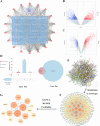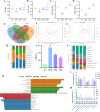Effects of Paeoniae Radix Rubra on lowering lipid via bioinformatics and gut microbiome
- PMID: 40596614
- PMCID: PMC12215427
- DOI: 10.1038/s41598-025-08486-1
Effects of Paeoniae Radix Rubra on lowering lipid via bioinformatics and gut microbiome
Abstract
Hyperlipidemia, a metabolic disorder characterized by abnormal lipid levels, is closely linked to an increased risk of cardiovascular disease. In this study, we investigated the hypolipidemic properties of Paeoniae Radix Rubra and its regulatory effects on gut microbiota composition in a high-fat diet model. Using UHPLC-QE-MS/MS, we identified its chemical constituents and applied bioinformatics, network pharmacology, and molecular docking to virtually screen for bioactive compounds and molecular targets. Gelomulide N and (E)-5-[(1 S,4aR,8aR)-2-formyl-5,5,8a-trimethyl-1,4,4a,6,7,8-hexahydronaphthalen-1-yl]-3-(acetoxymethyl)pent-2-enoic acid were identified as potential active compounds. Paeoniae Radix Rubra exhibited notable hypolipidemic, hepatoprotective, and gut microbiota-restoring effects, potentially influencing the mevalonate pathway by interacting with proteins such as P53, HMGCR, and SREBP2, which may contribute to reduced cholesterol synthesis. These findings indicate that the Paeoniae Radix Rubra could serve as a potential therapeutic strategy for hyperlipidemia, possibly mediated through modulation of lipid metabolism pathways and gut microbiota remodeling.
Keywords: Paeoniae Radix Rubra; Bioinformatics; Gut microbiota; Hyperlipidemia; Mevalonate pathway.
© 2025. The Author(s).
Conflict of interest statement
Declarations. Competing interests: The authors declare no competing interests. Ethics approval: All animal experiments followed ARRIVE guidelines and the NIH Guide for the Care and Use of Laboratory Animals (NIH Publication No. 8023, revised 1978) and the Experimental Animal Ethics Committee of Changchun University of Chinese Medicine (Ethics Approval No.: 2020262).
Figures








Similar articles
-
Mechanisms of Microctis Folium in Hyperlipidemia: Integrating Serum Pharmacochemistry, Network Pharmacology, and Transcriptomics.Drug Des Devel Ther. 2025 Jul 11;19:5973-5991. doi: 10.2147/DDDT.S532052. eCollection 2025. Drug Des Devel Ther. 2025. PMID: 40665988 Free PMC article.
-
Inonotus obliquus polysaccharides improve hyperlipidemia with respect to lipid synthesis and intestinal flora modulation.Int J Biol Macromol. 2025 Aug;320(Pt 3):145688. doi: 10.1016/j.ijbiomac.2025.145688. Epub 2025 Jul 12. Int J Biol Macromol. 2025. PMID: 40659272
-
Lactiplantibacillus plantarum TCCC11824 exerts hypolipidemic and anti-obesity effects through regulation of NF-κB-HMGCR pathway and gut microbiota in mice and clinical patients.Nutrition. 2025 Feb;130:112598. doi: 10.1016/j.nut.2024.112598. Epub 2024 Oct 18. Nutrition. 2025. PMID: 39612553
-
Paeoniae Radix Rubra: A Review of Ethnopharmacology, Phytochemistry, Pharmacological Activities, Therapeutic Mechanism for Blood Stasis Syndrome, and Quality Control.Chem Biodivers. 2024 Aug;21(8):e202401119. doi: 10.1002/cbdv.202401119. Epub 2024 Jul 23. Chem Biodivers. 2024. PMID: 38850115 Review.
-
Gut Microbiota-Targeted Therapeutics for Metabolic Disorders: Mechanistic Insights into the Synergy of Probiotic-Fermented Herbal Bioactives.Int J Mol Sci. 2025 Jun 7;26(12):5486. doi: 10.3390/ijms26125486. Int J Mol Sci. 2025. PMID: 40564947 Free PMC article. Review.
References
-
- Zhang, Y., Wang, Z., Jin, G., Yang, X. & Zhou, H. Regulating dyslipidemia effect of polysaccharides from pleurotus ostreatus on fat-emulsion-induced hyperlipidemia rats. Int. J. Biol. Macromol.101, 107–116. 10.1016/j.ijbiomac.2017.03.084 (2017). - PubMed
-
- Svegliati-Baroni, G. et al. Glucagon-like peptide-1 receptor activation stimulates hepatic lipid oxidation and restores hepatic signalling alteration induced by a high-fat diet in nonalcoholic steatohepatitis. Liver Int.31, 1285–1297. 10.1111/j.1478-3231.2011.02462.x (2011). - PubMed
MeSH terms
Substances
Grants and funding
LinkOut - more resources
Full Text Sources
Medical
Research Materials
Miscellaneous

